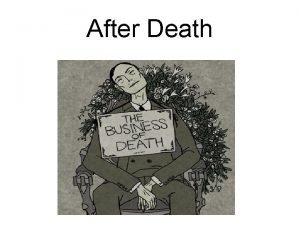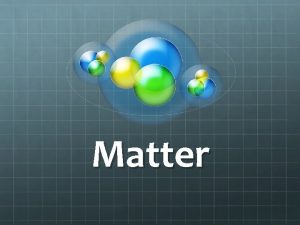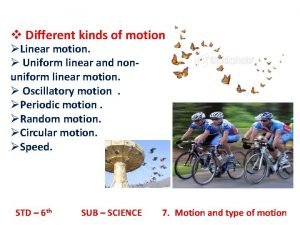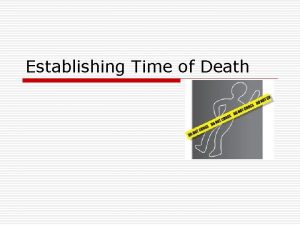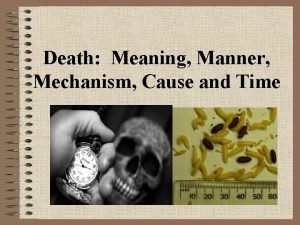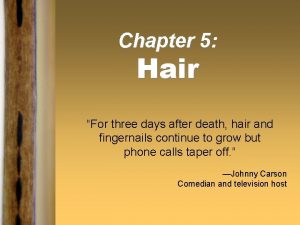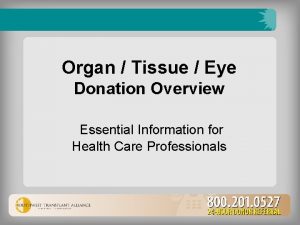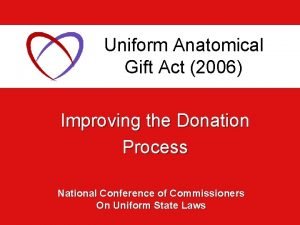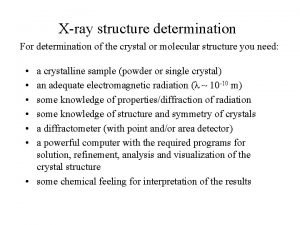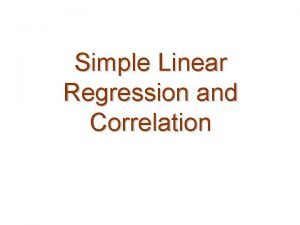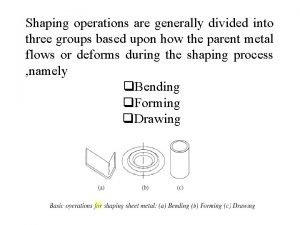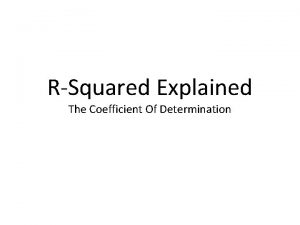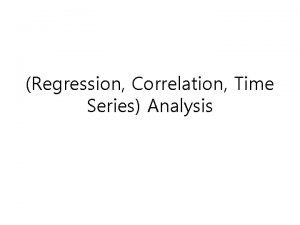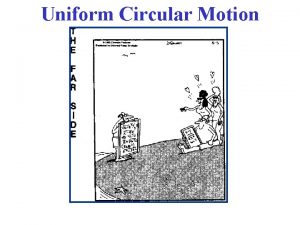After Death Uniform Determination of Death Act UDDA













































- Slides: 45

After Death

Uniform Determination of Death Act (UDDA) • Drafted in 1980 by a group of appointed individuals from each state • Purpose was to provide a “comprehensive and medically sound” defintion of death

Definition of Death Irreversible cessation of: • circulation of blood in the body • all respiratory functions • all function of the entire brain (including the brain stem)

Death Masks • Death Masks show the facial expressions immediately after death. • Before modern photography death masks were created as a visual memento • Made of wax, clay or plaster Mt. Nebo – AL cemetary

Death Mask of Lenin

Death Mask of Lincoln

Autopsy Autopsies are mandatory when the death: • Is a Homicide • Is Unexplained • Is Sudden • Occurs in any prisoner or child • Occurs while hospitalized

Before Body Disposal Organ donation – the removal of tissues from a recently deceased body or a living donor. • Organs, tissues, stem cells and blood and platelets may be donated. • Most people can be donors (HIV positive, cancer patients, and those with active or systemic infection cannot donate).

Before Body Disposal (cont) • The organs that may be donated are the kidneys, heart, lungs, liver, pancreas, and the intestines. • Donated organs must be transplanted within 6 -72 hours and cannot be stored. • Tissues, stem cells, blood and platelets may be stored for later use.

Before Body Disposal (cont) • As of July 2012, 114, 712 people are on the waiting list for a donation. • Every 10 minutes a name is added to the waiting list

Body Disposal • There are many opinions about the correct way to dispose of a body. • These opinions may be influenced by religion, fear, cultural beliefs and taboos. • Methods of disposal include: – Burial • Eco-Cemetery • At sea • Sky burial – Cremation – Mummification – Medical Research – Stuffed – Lye – Freeze dried

Body Disposal - Burial • After death, most families use the services of a funeral home. • A funeral home, funeral parlor or mortuary, is a business that provides burial and funeral services for the deceased and their families. • The funeral home will embalm the body and help with burial arrangements. • The word burial comes from the word birgan which means to conceal.

The Process of Embalming • Embalming is done to delay decomposition and allow time for the funeral. • Blood and body fluids are removed and replaced with embalming fluid.

Body Disposal Burial • Tom M Wages Funeral Services, LLC located in Lawrenceville, Georgia • Funeral homes may offer both traditional burial and cremation.

Body Disposal - Burial • A coffin is the general term for the container in which a corpse is buried. • Coffins have been made of clay, stone, papier-mache, turtle shells, baskets, fabrics, and metals. • Coffins are sculpted to the body shape.

Body Disposal Burial • For many years, coffins were a symbol of social status. • The poor were buried in a shroud. • However, the poor were transported to the cemetery in a slip-coffin. • A slip-coffin had a hinged bottom to allow the body to drop into the grave. • The coffin was then returned to the church for reuse.

Body Disposal Burial • Although incorrect, many people use the terms coffin and casket interchangeably. • A casket is rectangular and the lid is hinged for viewing.

Body Disposal- Burial • The term cemetery means sleeping chamber. • While both are burial grounds, a cemetery and graveyard should not be used interchangeably. • A graveyard is next to a place of worship. • A cemetery may be located anywhere and is not affiliated with any religion.

Body Disposal Burial

Body Disposal - Burial • An eco-cemetery (aka green burial ground or natural burial ground) is a new alternative place for burial. • The body is not embalmed and is placed in a biodegradable coffin or a shroud. • The body is returned to the earth to decompose or recycle naturally. • Trees or other natural objects are used to mark the grave.

Body Disposal - Burial • Greensprings Natural Cemetery Newfield, NY

Body Disposal - Burial • A burial at sea disposes of human remains into the ocean usually from a ship or boat. • In the United States, ashes have to be scattered at least 3 miles from shore and a body must be dropped at least 600 ft deep.

Body Disposal - Burial • Once common in Tibet, a sky burial involves cutting a body into small pieces and placing these pieces on top of a mountain to give “alms to the birds”. • It was considered a bad omen if the birds did not eat all of the remains.

Body Disposal - Cremation • Cremation reduces a corpse by burning. • This occurs in a crematorium. • Temperatures must reach 870980 °C (1600 -1800 °F) to totally disintegrate the body. • The “ashes” are placed into a container chosen by the family.

Body Disposal - Mummification • Mummification involves two steps: embalming and wrapping. • All organs (except the heart) are removed and placed into canopic jars. • The body is covered in natron to remove all fluids.

Body Disposal - Mummification • After 40 -70 days, the natron is removed and the body is rubbed with oils. • Next, the mummy is wrapped using a specific method. – First the head and neck are wrapped with strips of fine linen. Then the fingers and the toes are individually wrapped. – The arms and legs are wrapped separately and then tied together. – Finally, the body the wrapped and placed into a sarcophagus (ornate box).

Body Disposal Mummification

Body Disposal Medical Research • Bodies cannot be purchased. • The donation must be arranged before death. • A medical school or research facility will use the body for teaching purposes or disease studies. • Bodies can be rejected and then the family would be responsible for burial.

Body Disposal The Body Farm • The Body Farm is a research facility that studies human decomposition. • There is no cost to the family if they live within 200 miles of Knoxville, Tennessee.

Body Disposal - Stuffed • Jeremy Bentham asked that his body be dissected and the skeleton used to create a stuffed figure that sat in a chair. • His bones are covered in his clothes and topped with a wax head.

Body Disposal - Lye • Bodies are dissolved in lye so they may be flushed down a drain. • This process occurs in a stainless steel cylinder that is similar to a pressure cooker.

Body Disposal - Freeze Dried • The corpse is frozen to minus 18 degrees Celsius and then submerged in liquid nitrogen. • The body becomes very brittle. • Vibrations then cause the body to break into organic powder.

Saponification • Saponification is the chemical process of converting body fat into adiopcere. • Adiopcere which is also known as grave wax is a crumbly, waxy, water-insoluble material that is made mainly of fatty acids. It is grayish-white or tan in color. • Body fats will turn into adiopcere under certain conditions.

Conditions for Saponification The corpse is a woman, infant or obese person. More body fat is found in these individuals. • The body is located in an oxygen deprived location that is also cold and humid. For example, a body buried in very wet ground or in the mud at the bottom of a lake could turn into adiopcere. • If enough potassium is also present in the environment, the adiopcere is softer. These bodies are called Soap Mummies.

The Soap Lady

Plastination • Plastination is the process of preserving a body that retains most of its original features, does not smell or decay and can be touched. • The process has four steps.

Plastination Steps: 1. Body is embalmed to halt decomposition. Formaldehyde solution is used in the embalming process. 2. After necessary dissections, the body is placed into a bath of acetone under freezing conditions. Cold temperature causes the acetone replace any water found in the cells. 3. The body is placed into a polymer bath. A vacuum is created so the acetone will boil, vaporize and leave the cell. As the acetone leaves the cell, it draws the polymer into the cell. At the end of this step, all of the body’s cells are filled with plastic. 4. The plastic body is cured by a gas, heat or UV light. This causes the body to harden.

Plastination (cont) • In November of 1979, Gunther von Hagens patented this process. • He has since used it to create BODIES The Exhibition is currently in Atlanta. • • http: //www. bodiestheexhibition. com/

Organ Theft • Organ theft is the practice of stealing body organs during surgery or embalming. These organs are then sold on the Black Market or used for transplants

Cannibalism • Not always related to hunger • Ancient funerary ritual • Yanomami in the Amazon rain forest cremate the dead and eat ash mush to ensure that the spirit is not lost • Egyptians believed that they were gifted with crops so they would not have to cannibalize

Body Disposal Choice • Many times, the method of body disposal is chosen in order to destroy evidence. • For example, buried bodies may be exhumed with a court order and reautopsied. A cremated body is destroyed and all evidence of foul play is gone.

Death Rituals • Burying a knife with a corpse cuts ties with the living. • To prevent haunting by the spirit of the dead, Zulu (South Africa) men walk backwards while carrying the body to the grave • Kings and Queens are buried in the walls and floors of Westminster Abbey • In Sulawesi (Indonesia), infants are buried in trees

Interesting Facts About Death • The mosquito is responsible for the most human deaths worldwide • President Andrew Jackson’s parrot was removed from his funeral for swearing • In Erwin, TN an elephant was hanged for murder • Right handed people live on average 9 years longer than left handed people • A cockroach can live 9 days without a head


 Uniform determination of death act 1981
Uniform determination of death act 1981 After me after me after me
After me after me after me If any man wants to come after me
If any man wants to come after me How does okonkwo act for two days after ikemefuna's death
How does okonkwo act for two days after ikemefuna's death How do you classify uniform and non-uniform mixtures?
How do you classify uniform and non-uniform mixtures? Homogeneous vs heterogeneous mixture
Homogeneous vs heterogeneous mixture Aliran tak seragam
Aliran tak seragam Uniform and non uniform linear motion
Uniform and non uniform linear motion Macbeth act 3-5 summary
Macbeth act 3-5 summary Corpse wax
Corpse wax The great gatsby slagle
The great gatsby slagle What are the 5 manners of death?
What are the 5 manners of death? Heat stiffening and cold stiffening
Heat stiffening and cold stiffening After death images
After death images What do muslims believe about life after death
What do muslims believe about life after death Meaning:manner
Meaning:manner Questioning god about death
Questioning god about death Man is the
Man is the Social injustice examples
Social injustice examples Interrupted medulla
Interrupted medulla Featal distress
Featal distress After death hair
After death hair Uniform anatomical gift act
Uniform anatomical gift act Uniform anatomical gift act
Uniform anatomical gift act Uniform anatomical gift act definition
Uniform anatomical gift act definition Somatic death and molecular death
Somatic death and molecular death Single crystal diffractometer
Single crystal diffractometer Coefficient of determination interpretation
Coefficient of determination interpretation Blank determination example
Blank determination example X-linked punnett square
X-linked punnett square Sex determination brainpop quiz answers
Sex determination brainpop quiz answers Sex linkage
Sex linkage Self-determination worksheets pdf
Self-determination worksheets pdf Sample size determination
Sample size determination Shipping point determination
Shipping point determination Shipping point determination sap
Shipping point determination sap What does the coefficient of determination tell us
What does the coefficient of determination tell us Requirement determination example
Requirement determination example Durbin watson test interpretation
Durbin watson test interpretation Quality determination
Quality determination Bradford method
Bradford method Determination in sanskrit
Determination in sanskrit Price and output determination under monopoly
Price and output determination under monopoly Serious tone
Serious tone Grit personality trait
Grit personality trait Microhematocrit determination
Microhematocrit determination
